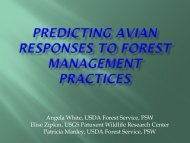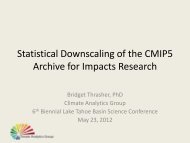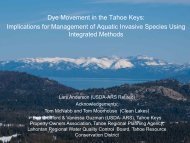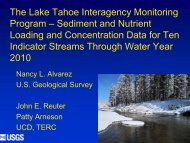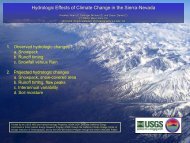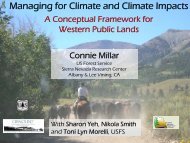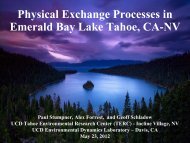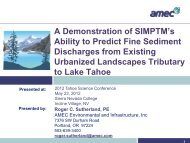Sahoo, Goloka Behari
Sahoo, Goloka Behari
Sahoo, Goloka Behari
You also want an ePaper? Increase the reach of your titles
YUMPU automatically turns print PDFs into web optimized ePapers that Google loves.
Lake Clarity Model: Development of<br />
Updated Algorithms to Define Particle<br />
Aggregation and Settling in Lake Tahoe<br />
<strong>Goloka</strong> B. <strong>Sahoo</strong><br />
S. Geoffrey Schladow<br />
John E. Reuter<br />
Daniel Nover<br />
David Jassby
Lake Clarity Model<br />
Weather, Precipitation<br />
Tributaries<br />
Land Use<br />
Groundwater<br />
Atmospheric Deposition<br />
Shoreline Erosion<br />
Total Pollutant Load to Lake Tahoe<br />
CDOM<br />
Nutrients (N, P)<br />
Mineral<br />
Particles<br />
Light Scattering<br />
and Absorption<br />
Phytoplankton<br />
Growth<br />
Zooplankton<br />
Growth<br />
Loss<br />
(coagulation<br />
and settling)<br />
Secchi<br />
Depth<br />
Detritus<br />
Loss<br />
Death<br />
Loss<br />
Sediment<br />
Hydrodynamic Model
LCM Modification after 2010<br />
• Lake Clarity Model (<strong>Sahoo</strong>, G. B., Schladow, S.G. and Reuter, J. E.<br />
(2010) Effect of Sediment and Nutrient Loading on Lake Tahoe (CA-NV) Optical<br />
Conditions and Restoration Opportunities Using a Newly Developed Lake Clarity<br />
Model. Water Resources Research, doi:10.1029/2009WR008447)<br />
Lahontan and Nevada Division of Environmental Protection (NDEP), 2010. Lake<br />
Tahoe Total Maximum Daily Load Technical Report. 340 p.<br />
• Introduction of Turbulent Diffusion Model to LCM<br />
(<strong>Sahoo</strong>, G. B., Schladow, S.G. and Reuter, J. E. (2012) Dynamics and<br />
Hydrologic Budget of a Large Oligotrophic Lake to Hydro-meteorological<br />
Inputs using Predictive Model, under Revision for Journal of Hydrology<br />
• Updated stream particles using measured data 2002-2010 (D.<br />
Nover, 2011).<br />
• Fractal particle aggregation model (D. Jassby 2006 and <strong>Sahoo</strong><br />
after 2006).<br />
• Probability of aggregation
Swift (2004) and Swift et al. (2006)<br />
Fraction of scattering or ab sorp tion<br />
100%<br />
90<br />
80<br />
70<br />
60<br />
50<br />
40<br />
30<br />
20<br />
Organic particles 25%<br />
Inorganic particles 58%<br />
b (chl)<br />
scattering<br />
b (inorganic)<br />
scattering<br />
10<br />
0<br />
Water molecules and CDOM 17%<br />
a(w+CDOM)<br />
absorption<br />
Jan Ap r Jul Oct Jan Ap r Jul Oct Jan Ap r Jul Oct Jan Ap r Jul Oct<br />
1999 2000 2001 2002<br />
Time<br />
a(w+CDOM) b (water) b (inorganic) a* chl b (chl)
Particle Aggregation Theories<br />
1. Solid Particle Aggregation (SPA) Model (O’Melia, 1985)<br />
2. Fractal Particle Aggregation (FPA) Model (Jackson,<br />
1995, 2001)
Previous Particle Model<br />
1. Solid Particle Aggregation (SPA) Model<br />
2. Constant value for probability of aggregation (α)<br />
<br />
c<br />
<br />
i,<br />
n 1<br />
ci,<br />
n ci,<br />
n<br />
( l,<br />
m)<br />
i ci,<br />
lci,<br />
m ci,<br />
l<br />
( l,<br />
m)<br />
i ci,<br />
n wi,<br />
n <br />
<br />
<br />
E(<br />
n,<br />
z)<br />
i<br />
t 2<br />
z z<br />
<br />
<br />
z<br />
l m n<br />
l 1<br />
<br />
<br />
<br />
where c l<br />
, c m<br />
, and c n<br />
are number concentration of particles (# m -3 ) of size l, m, and<br />
n, respectively, is a collision efficiency factor, reflecting the stability of the<br />
particles and the surface chemistry of the system, (l, m) is a collision frequency<br />
that depends on the inter-particle (particles of size l and m) contacts, w n<br />
(m s -1 ) is<br />
the settling velocity of particles of size n, and E(n, z) is an exchange coefficient,<br />
accounting for turbulent and molecular effects. The expression l + m n under<br />
the summation denotes the condition that M l<br />
+ M m<br />
= M n<br />
, thus ensuring<br />
conservation of mass.
New algorithms<br />
1. Fractal Particle Aggregation (FPA) Model (modified<br />
Jackson, 2001)<br />
2. Variable probability of particle aggregation (α)<br />
We postulated that probability of aggregation is function of particle<br />
size distribution, particle concentration, and phytoplankton<br />
concentration.
Modification contd.<br />
Chlorophyll a: Literature (Passow, 2011) suggests that Transparent<br />
Exopolymeric Particles (TEP) highly correlates with Chl a. TEP accounts<br />
for particles’ stickiness.<br />
Particle Concentration: The probability of aggregation increases as<br />
the concentration of particles increases.<br />
Particle size distribution: as smaller particles concentration is<br />
higher to large particles α is inversely proportional to particle size (r)<br />
The constant (C a ): Calibrated<br />
3. Both SPA and FPA conserve mass though the area available for collision<br />
is more for the case of FPA (Lee et al. 2000; Burd and Jackson, 2009). The<br />
new α was used for both SPA and FPA.<br />
4. Stoke’s law estimates settling velocity for SPA. For FPA, settling velocity is<br />
based on fractal dimension. Both use the three different processes: Brownian<br />
diffusion, fluid shear, and differential settling for collision frequency.
Secchi depth (m)<br />
Results (Annual Average SD)<br />
0<br />
1999 2000 2001 2002 2003 2004 2005 2006 2007 2008<br />
5<br />
10<br />
15<br />
20<br />
25<br />
30<br />
Measured constant coag SPA FPA
Particles (10 10 m -3 )<br />
Particles (10 10 m -3 )<br />
1999<br />
1999<br />
2000<br />
2000<br />
2000<br />
2000<br />
2001<br />
2001<br />
2002<br />
2002<br />
2003<br />
2003<br />
2004<br />
2004<br />
2005<br />
2005<br />
2006<br />
2006<br />
2007<br />
2007<br />
2008<br />
2008<br />
Results (Lake<br />
Particle 0.5-1μm)<br />
Particles (10 10 m -3 )<br />
4<br />
3<br />
2<br />
1<br />
(a)<br />
Measured at MLTP<br />
DLM-WQ: SPA<br />
DLM-WQ: FPA<br />
Surface (0.5-1mm)<br />
0<br />
4<br />
3<br />
2<br />
1999<br />
(b)<br />
2000<br />
2000<br />
2001<br />
2002<br />
Measured at MLTP<br />
DLM-WQ: SPA<br />
DLM-WQ: FPA<br />
2003<br />
2004<br />
2005<br />
2006<br />
10 m from surface (0.5-1mm)<br />
2007<br />
2008<br />
1<br />
0<br />
4<br />
(c)<br />
50 m from surface (0.5-1mm)<br />
3<br />
Measured at MLTP<br />
DLM-WQ: SPA<br />
DLM-WQ: FPA<br />
2<br />
1<br />
0
Particles (10 9 m -3 )<br />
Particles (10 9 m -3 )<br />
Particles (10 9 m -3 )<br />
1999<br />
1999<br />
1999<br />
2000<br />
2000<br />
2000<br />
2000<br />
2000<br />
2000<br />
2001<br />
2001<br />
2001<br />
2002<br />
2002<br />
2002<br />
2003<br />
2003<br />
2003<br />
2004<br />
2004<br />
2004<br />
2005<br />
2005<br />
2005<br />
2006<br />
2006<br />
2006<br />
2007<br />
2007<br />
2007<br />
2008<br />
2008<br />
2008<br />
Results (Lake<br />
Particle 1-2μm)<br />
6<br />
5<br />
4<br />
3<br />
(b)<br />
Measured at MLTP<br />
DLM-WQ: SPA<br />
DLM-WQ: FPA<br />
10 m from surface (1-2mm)<br />
2<br />
1<br />
0<br />
6<br />
5<br />
4<br />
3<br />
(a)<br />
Measured at MLTP<br />
DLM-WQ: SPA<br />
DLM-WQ: FPA<br />
Surface (1-2mm)<br />
2<br />
1<br />
0<br />
7<br />
6<br />
5<br />
4<br />
(c)<br />
50 m from surface (1-2mm)<br />
Measured at MLTP<br />
DLM-WQ: SPA<br />
DLM-WQ: FPA<br />
3<br />
2<br />
1<br />
0
Particles (10 8 m -3 )<br />
Particles (10 8 m -3 )<br />
1999<br />
1999<br />
2000<br />
2000<br />
2000<br />
2000<br />
2001<br />
2001<br />
2002<br />
2002<br />
2003<br />
2003<br />
2004<br />
2004<br />
2005<br />
2005<br />
2006<br />
2006<br />
2007<br />
2007<br />
2008<br />
2008<br />
Results (Lake<br />
Particle 2-4μm)<br />
Particles (10 8 m -3 )<br />
10<br />
8<br />
6<br />
4<br />
2<br />
(a)<br />
Measured at MLTP<br />
DLM-WQ: SPA<br />
DLM-WQ: FPA<br />
Surface (2-4mm)<br />
10<br />
0<br />
8<br />
6<br />
1999<br />
(b)<br />
2000<br />
2000<br />
2001<br />
2002<br />
2003<br />
2004<br />
2005<br />
2006<br />
10 m from surface (2-4mm)<br />
Measured at MLTP<br />
DLM-WQ: SPA<br />
DLM-WQ: FPA<br />
2007<br />
2008<br />
4<br />
2<br />
0<br />
10<br />
8<br />
6<br />
(c)<br />
50 m from surface (2-4mm)<br />
Measured at MLTP<br />
DLM-WQ: SPA<br />
DLM-WQ: FPA<br />
4<br />
2<br />
0
Particles (10 8 m -3 )<br />
Particles (10 8 m -3 )<br />
1999<br />
1999<br />
2000<br />
2000<br />
2000<br />
2000<br />
2001<br />
2001<br />
2002<br />
2002<br />
2003<br />
2003<br />
2004<br />
2004<br />
2005<br />
2005<br />
2006<br />
2006<br />
2007<br />
2007<br />
2008<br />
2008<br />
Results (Lake<br />
Particle 4-8μm)<br />
Particles (10 8 m -3 )<br />
3<br />
2<br />
1<br />
(a)<br />
Surface (4-8mm)<br />
Measured at MLTP<br />
DLM-WQ: SPA<br />
DLM-WQ: FPA<br />
0<br />
3<br />
2<br />
1999<br />
(b)<br />
2000<br />
2000<br />
2001<br />
Measured at MLTP<br />
DLM-WQ: SPA<br />
DLM-WQ: FPA<br />
2002<br />
2003<br />
2004<br />
2005<br />
2006<br />
10 m from surface (4-8mm)<br />
2007<br />
2008<br />
1<br />
0<br />
3<br />
(c)<br />
50 m from surface (4-8mm)<br />
2<br />
Measured at MLTP<br />
DLM-WQ: SPA<br />
DLM-WQ: FPA<br />
1<br />
0
Particles (10 7 m -3 )<br />
Particles (10 7 m -3 )<br />
Particles (10 7 m -3 )<br />
1999<br />
1999<br />
1999<br />
2000<br />
2000<br />
2000<br />
2000<br />
2000<br />
2000<br />
2001<br />
2001<br />
2001<br />
2002<br />
2002<br />
2002<br />
2003<br />
2003<br />
2003<br />
2004<br />
2004<br />
2004<br />
2005<br />
2005<br />
2005<br />
2006<br />
2006<br />
2006<br />
2007<br />
2007<br />
2007<br />
2008<br />
2008<br />
2008<br />
Results (Lake<br />
Particle 8-16μm)<br />
8<br />
7<br />
6<br />
5<br />
4<br />
3<br />
2<br />
1<br />
0<br />
8<br />
7<br />
6<br />
5<br />
4<br />
3<br />
2<br />
1<br />
0<br />
8<br />
7<br />
6<br />
5<br />
(a)<br />
(b)<br />
(c)<br />
Surface (8-16mm)<br />
Measured at MLTP<br />
DLM-WQ: Solid<br />
DLM-WQ: Fractal<br />
10 m from surface (8-16mm)<br />
Measured at MLTP<br />
DLM-WQ: SPA<br />
DLM-WQ: FPA<br />
50 m from surface (8-16mm)<br />
Measured at MLTP<br />
DLM-WQ: Solid<br />
DLM-WQ: Fractal<br />
4<br />
3<br />
2<br />
1<br />
0
Secchi depth (m)<br />
Secchi depth (m)<br />
1999<br />
2000<br />
2001<br />
2002<br />
2003<br />
2004<br />
2005<br />
2006<br />
2007<br />
2008<br />
0<br />
Results using new α<br />
and Solid Particle Algorithm Model<br />
1999 2000 2001 2002 2003 2004 2005 2006 2007 2008<br />
5<br />
10<br />
15<br />
Annual Average<br />
20<br />
25<br />
30<br />
Measured<br />
Daily<br />
LCM<br />
40<br />
35<br />
30<br />
25<br />
20<br />
15<br />
10<br />
5<br />
0<br />
Measured<br />
LCM
Secchi Depth (m)<br />
Secchi Depth (m)<br />
Results using new α<br />
and Solid Particle Algorithm Model<br />
Winter (Dec-Mar)<br />
2000 2001 2002 2003 2004 2005 2006 2007 2008<br />
0<br />
5<br />
Measured<br />
LCM<br />
10<br />
15<br />
Seasonal trend<br />
20<br />
25<br />
30<br />
Summer (June-Sep)<br />
2000 2001 2002 2003 2004 2005 2006 2007 2008<br />
0<br />
5<br />
Measured<br />
LCM<br />
10<br />
15<br />
20<br />
25
Summary<br />
• Long term measured lake and stream particle data helps to estimate the<br />
trend and calibrate the model well<br />
• The new probability of aggregation term captures well the seasonal and<br />
interannual Secchi depth variation compared to constant number.<br />
• Both FPA and SPA conserve mass though area available for collision is<br />
more for FPA case. So, smaller particles are aggregated at higher rate for<br />
the case of FPA. Because of that predicted Secchi depth using FPA is<br />
little higher to using SPA.<br />
• This is not the end of modification. Availability of new dataset will help<br />
to find the ground truths of many processes and will ask for modification.
ACKNOWLEDGEMENTS<br />
This research is supported by University of California<br />
Davis and grants from the USDA Forest Service Pacific<br />
Southwest Research Station using funds provided by the<br />
Bureau of Land Management through the sale of public<br />
lands as authorized by the Southern Nevada Public Land<br />
Management Act.



